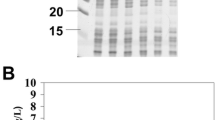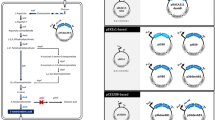Abstract
Corynebacterium glutamicum is an important microorganism in the biochemical industry for the production of various platform chemicals. However, despite its importance, a limited number of studies have been conducted on how to constitute gene expression cassettes in engineered C. glutamicum to obtain desired amounts of the target products. Therefore, in this study, six expression cassettes for the expression of the second lysine decarboxylase of Escherichia coli, LdcC, were constructed using six synthetic promoters with different strengths and were examined in C. glutamicum for the production of cadaverine. Among six expression cassettes, the expression of the E. coli ldcC gene under the PH30 promoter supported the highest production of cadaverine in flask and fed-batch cultivations. A fed-batch fermentation of recombinant C. glutamicum expressing E. coli ldcC gene under the PH30 promoter resulted in the production of 40.91 g/L of cadaverine in 64 h. This report is expected to contribute toward developing engineered C. glutamicum strains to have desired features.




Similar content being viewed by others
References
Willke, T., & Vorlop, K. D. (2004). Industrial bioconversion of renewable resources as an alternative to conventional chemistry. Applied Microbiology and Biotechnology, 66, 131–142.
Jang, Y. S., Kim, B. J., Shin, J. H., Choi, Y. J., Choi, S., Song, C. W., Lee, J. M., Park, H. G., & Lee, S. Y. (2012). Bio-based production of C2-C6 platform chemicals. Biotechnology and Bioengineering, 109, 2437–2459.
McKinlay, J. B., Vieille, C., & Zeikus, J. G. (2007). Prospects for a bio-based succinate industry. Applied Microbiology and Biotechnology, 76, 727–740.
Moon, T. S., Yoon, S. H., Lanza, A. M., Roy-Mayhew, J. D., & Prather, K. L. J. (2009). Production of glucaric acid from a synthetic pathway in recombinant Escherichia coli. Applied Environmental and Microbiology, 75, 589–595.
Mimitsuka, T., Sawai, H., Hatsu, M., & Yamda, K. (2007). Metabolic engineering of Corynebacterium glutamicum for cadaverine fermentation. Bioscience, Biotechnology, and Biochemistry, 71, 2130–2135.
Park, S. J., Kim, E. Y., Noh, W., Park, H. M., Oh, Y. H., Lee, S. H., Song, B. K., Jegal, J. G., & Lee, S. Y. (2013). Metabolic engineering of Escherichia coli for the production of 5-aminovalerate and glutarate as C5 platform chemicals. Metabolic Engineering, 16, 42–47.
Park, S. J., Oh, Y. H., Noh, W., Kim, H. Y., Shin, J. H., Lee, E. G., Lee, S., David, Y., Baylon, M. G., Song, B. K., Jegal, J., Lee, S. Y., & Lee, S. H. (2014). High-level conversion of L-lysine into 5-aminovalerate that can be used for nylon 6,5 synthesis. Biotechnology Journal, 9, 1322–1328.
Qian, Z. G., Xia, X., & Lee, S. Y. (2011). Metabolic engineering of Escherichia coli for the production of cadaverine: a five carbon diamine. Biotechnology and Bioengineering, 108, 93–103.
Nešvera, J., & Pátek, M. (2008). Corynebacteria: genomics and molecular biology. Norfolk: Caister Academic.
Knoppová, M., Phensaijai, M., Veselý, M., Zemanová, M., Nešvera, J., & Pátek, M. (2007). Plasmid vectors for testing in vivo promoter activities in Corynebacterium glutamicum and Rhodococcus erythropolis. Current Microbiology, 55, 234–239.
Kirchner, O., & Tauch, A. (2003). Tools for genetic engineering in the amino acid-producing bacterium Corynebacterium glutamicum. Journal of Biotechnology, 104, 287–299.
Tatsumi, N., & Inui, M. (2013). Corynebacterium glutamicum: biology and biotechnology. New York: Springer.
Yim, S. S., An, S. J., Kang, M. S., Lee, J. H., & Jeong, K. J. (2013). Isolation of fully synthetic promoters for high-level gene expression in Corynebacterium glutamicum. Biotechnology and Bioengineering, 110, 2959–2971.
Buschke, N., Schröder, H., & Wittmann, C. (2011). Metabolic engineering of Corynebacterium glutamicum for production of 1,5-diaminopentane from hemicellulose. Biotechnology Journal, 6, 306–317.
Kind, S., & Wittmann, C. (2011). Bio-based production of the platform chemical 1,5-diaminopentane. Applied Microbial and Biotechnology, 91, 1287–1296.
Kind, S., Jeong, W. K., Schröder, H., Zelder, O., & Wittmann, C. (2010). Identification and elimination of the competing N-acetyldiaminopentane pathway for improved production of diaminopentane by Corynebacterium glutamicum. Applied Environmental and Microbiology, 76, 5175–5180.
Kind, S., Jeong, W. K., Schröder, H., & Wittmann, C. (2010). Systems-wide metabolic pathway engineering in Corynebacterium glutamicum for bio-based production of diaminopentane. Metabolic Engineering, 12(4), 341–51.
Kind, S., Neubauer, S., Becker, J., Yamamoto, M., Volkert, M., Abendroth, G., Zelder, O., & Wittmann, C. (2014). From zero to hero—production of bio-based nylon from renewable resources using engineered Corynebacterium glutamicum. Metabolic Engineering, 25, 113–123.
Verseck, S., Häger, H., Karau, A., Eggeling, L., Sahm, H. (2008). Verfahrenzur fermentativen Herstellung von Cadaverin. DE 102007005072 A1.
Nakayama, K., & Araki, K. (1973). US patent, US3708395 A.
Hermosín, I., Chicón, R. M., & Cabezudo, M. D. (2003). Free amino acid composition and botanical origin of honey. Food Chemistry, 83, 263–268.
Acknowledgments
This work was supported by Industrial Strategic Technology Development Program (10047910, Production of bio-based cadaverine and polymerization of Biopolyamide 510) funded by the Ministry of Trade, Industry & Energy (MOTIE, Korea) and the Technology Development Program to Solve Climate Changes (Systems Metabolic Engineering for Biorefineries) from the Ministry of Science, and ICT and Future Planning (MSIP) through the National Research Foundation (NRF) of Korea (NRF-2012-C1AAA001-2012M1A2A2026556). Further support from the R&D Program of MOTIE/KEIT (10049674) is appreciated.
Author information
Authors and Affiliations
Corresponding authors
Additional information
Young Hoon Oh and Jae Woo Choi contributed equally to this work.
Rights and permissions
About this article
Cite this article
Oh, Y.H., Choi, J.W., Kim, E.Y. et al. Construction of Synthetic Promoter-Based Expression Cassettes for the Production of Cadaverine in Recombinant Corynebacterium glutamicum . Appl Biochem Biotechnol 176, 2065–2075 (2015). https://doi.org/10.1007/s12010-015-1701-4
Received:
Accepted:
Published:
Issue Date:
DOI: https://doi.org/10.1007/s12010-015-1701-4




